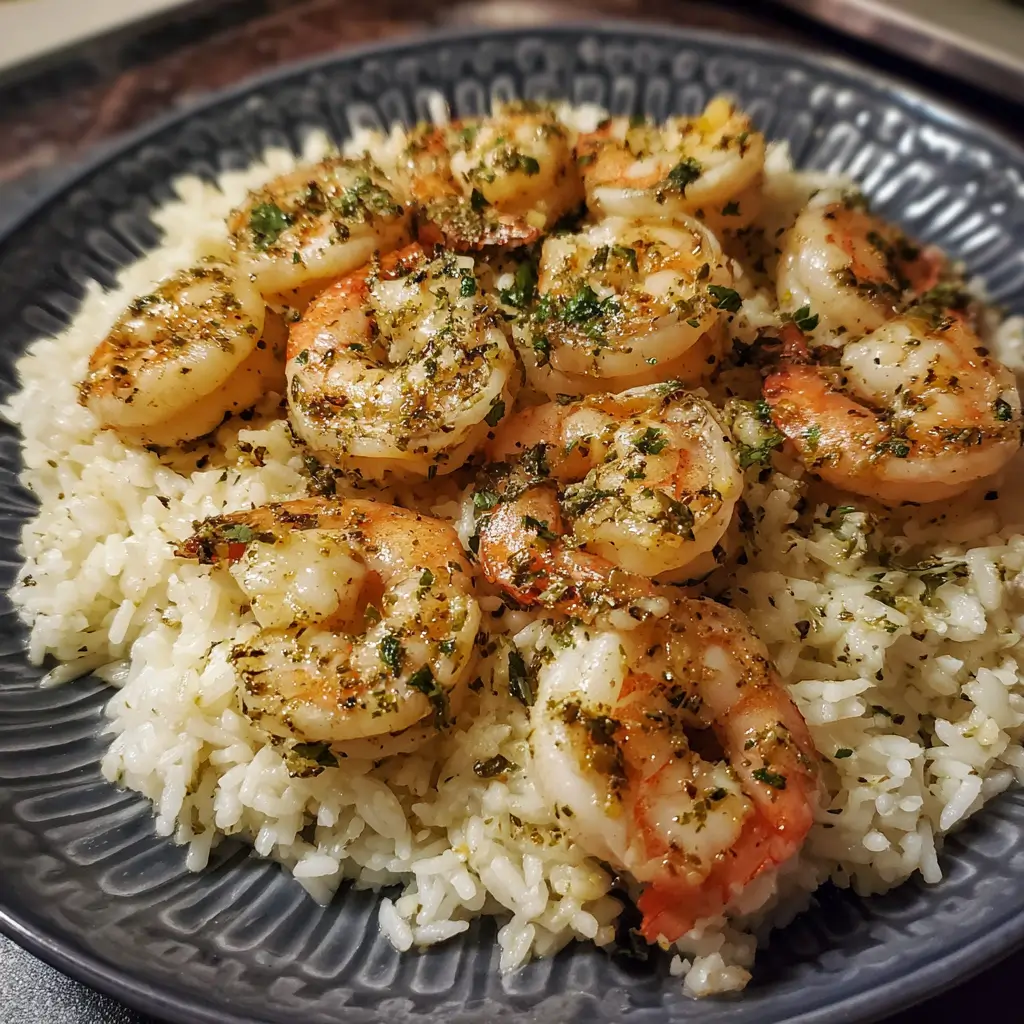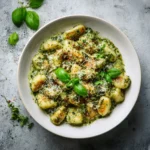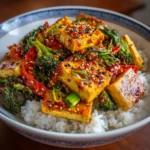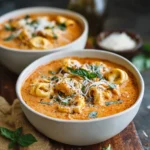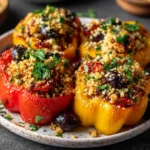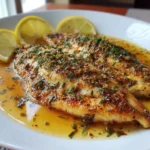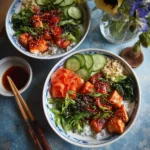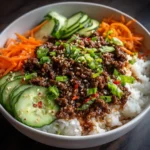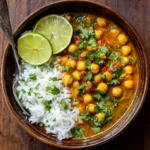Introduction
Garlic Lemon Shrimp and Rice is a vibrant, flavorful dish that brings together the bold taste of garlic, the bright tang of fresh lemon, and succulent shrimp—all served over fluffy, aromatic rice. This one-pan meal is not only quick and easy to prepare but also packed with rich Mediterranean-inspired flavors that make it perfect for weeknight dinners or impressing guests at a casual dinner party. Whether you’re looking for a healthy seafood option or simply craving something light yet satisfying, this recipe delivers on every level. With its golden-brown seared shrimp, zesty citrus notes, and fragrant herbs, Garlic Lemon Shrimp and Rice offers a restaurant-quality experience in the comfort of your own kitchen.
The History
While there is no single origin story for Garlic Lemon Shrimp and Rice, the dish draws influence from several culinary traditions around the Mediterranean and coastal regions where seafood plays a central role in daily meals. Countries like Greece, Italy, Spain, and Turkey have long celebrated simple preparations of fresh fish and shellfish with olive oil, garlic, lemon, and herbs—ingredients that form the backbone of this recipe. In Greek cuisine, for example, garides saganaki features shrimp baked in a tomato-feta sauce with similar aromatic elements. Italian dishes such as gamberi al limone highlight lemon and garlic sautéed shrimp, often served over pasta or rice. Over time, home cooks and chefs alike began combining these concepts with pilaf-style rice, creating a complete meal in one dish. The modern version of Garlic Lemon Shrimp and Rice evolved as part of a broader trend toward healthy, fast-prep meals that don’t compromise on flavor—making it a staple in contemporary American and global kitchens.
Ingredients Breakdown
- Shrimp: Large or jumbo peeled and deveined shrimp are ideal because they hold up well during cooking and offer a meaty texture. You can use fresh or high-quality frozen shrimp (thawed). Opt for wild-caught if possible for better flavor and sustainability.
- Rice: Long-grain white rice like basmati or jasmine works best due to its ability to stay fluffy and separate when cooked. Avoid short-grain or sticky rice varieties unless you prefer a creamier consistency.
- Garlic: Freshly minced garlic is essential—it provides the deep, pungent aroma and robust flavor that defines the dish. Don’t substitute jarred minced garlic if you want authentic taste.
- Lemons: Both lemon juice and zest are used to infuse brightness. Freshly squeezed juice ensures maximum flavor, while the zest adds concentrated citrus oil without extra acidity.
- Olive Oil: Extra virgin olive oil enhances richness and helps sauté ingredients evenly while contributing heart-healthy monounsaturated fats.
- Chicken or Vegetable Broth: Using broth instead of water elevates the flavor of the rice significantly. Low-sodium versions allow better control over salt content.
- Butter: A small amount of butter added at the end enriches the sauce, giving it a silky mouthfeel and balancing the sharpness of lemon.
- Herbs: Fresh parsley and optionally dill or basil add freshness and color. Dried herbs can be substituted in a pinch, though fresh ones are strongly preferred.
- Onion and Shallot: Finely diced yellow onion or shallot builds a savory base layer of flavor when sautéed before adding other ingredients.
- Seasonings: Salt, black pepper, red pepper flakes (for heat), and sometimes paprika or oregano round out the seasoning profile.
Step-by-Step Recipe
- Prep Ingredients: Begin by peeling and deveining the shrimp if not already done. Pat them dry thoroughly with paper towels to ensure proper searing. Mince 4–6 cloves of garlic depending on preference. Zest one lemon and juice two lemons (you’ll need about 1/3 cup juice). Dice one small yellow onion or shallot. Measure out 1 cup of long-grain rice and rinse under cold water until the water runs clear to remove excess starch.
- Sauté Aromatics: Heat 2 tablespoons of extra virgin olive oil in a large skillet or Dutch oven over medium heat. Add the diced onion and cook for 3–4 minutes until softened and translucent. Stir in the minced garlic and a pinch of red pepper flakes; cook for another 30 seconds to 1 minute until fragrant—be careful not to burn the garlic.
- Toast the Rice: Add the rinsed and drained rice to the pan. Stir continuously for 2–3 minutes until the grains become slightly translucent and begin to toast. This step enhances nuttiness and prevents mushiness later.
- Add Liquids: Pour in 2 cups of warmed chicken or vegetable broth and the juice of two lemons. Season with 1 teaspoon salt and 1/2 teaspoon black pepper. Stir once to combine, then bring the mixture to a gentle boil.
- Cook the Rice: Reduce heat to low, cover the skillet with a tight-fitting lid, and simmer for 15–18 minutes, or until the rice has absorbed all the liquid and is tender. Do not stir during this time to prevent stickiness.
- Prepare the Shrimp: While the rice cooks, season the shrimp with salt, pepper, and a drizzle of olive oil. In a separate non-stick skillet or directly on top of the finished rice (if space allows), heat 1 tablespoon of olive oil over medium-high heat. Sear the shrimp for 1–2 minutes per side until pink, opaque, and lightly caramelized. Remove from heat immediately to avoid overcooking.
- Combine and Finish: Once the rice is fully cooked, fluff it gently with a fork. Nestle the cooked shrimp into the rice. Sprinkle with lemon zest, chopped fresh parsley, and 1–2 tablespoons of unsalted butter. Cover again for 2–3 minutes to let the butter melt and flavors meld together.
- Serve: Transfer to serving plates or a large platter. Garnish with additional parsley, lemon wedges, and a sprinkle of red pepper flakes if desired. Serve immediately while hot.
Tips
- Dry Your Shrimp: Moisture is the enemy of searing. Always pat shrimp dry before cooking to achieve a beautiful golden crust rather than steaming them.
- Don’t Overcook the Shrimp: Shrimp cook very quickly and become rubbery if left too long on the heat. They’re done when they turn pink and form a loose “C” shape—never a tight “O.”
- Use Warm Broth: Adding warm broth to the rice helps maintain consistent temperature and promotes even absorption, leading to fluffier results.
- Rest After Cooking: Letting the rice sit covered for 5–10 minutes after turning off the heat improves texture through residual steam.
- Brighten Before Serving: A final squeeze of fresh lemon juice just before serving lifts the entire dish and balances the richness.
- One-Pan Option: For easier cleanup, consider arranging raw shrimp on top of the rice after adding the broth, then covering and cooking everything together. The shrimp will steam and finish perfectly alongside the rice.
- Layer Flavors: Build depth by deglazing the shrimp pan with a splash of white wine or broth and pouring those fond-rich juices over the finished dish.
Variations and Customizations
- Creamy Version: Stir in 1/4 cup of heavy cream, crème fraîche, or mascarpone at the end for a richer, silkier texture.
- Spicy Kick: Increase red pepper flakes or add sliced jalapeños, harissa paste, or a dash of cayenne for more heat.
- Herb Variations: Swap parsley for cilantro for a Latin twist, or try fresh dill for a Greek-inspired profile. Tarragon also pairs beautifully with lemon and seafood.
- Vegetable Add-Ins: Boost nutrition and texture by adding sautéed spinach, cherry tomatoes, artichoke hearts, roasted red peppers, peas, or asparagus.
- Protein Swaps: Replace shrimp with scallops, firm white fish (like cod or halibut), chicken breast strips, or tofu for different protein options.
- Dairy-Free: Omit butter and use a high-quality olive oil or vegan butter alternative to keep it dairy-free.
- Gluten-Free: Naturally gluten-free as written—just confirm your broth is certified GF if needed.
- Coconut Twist: Substitute half the broth with coconut milk and add a touch of curry powder for an exotic, tropical flair.
- Pilaf Style Upgrade: Toast rice with chopped almonds or pine nuts before adding liquid for a nutty crunch reminiscent of Middle Eastern pilafs.
- Wine-Infused: Deglaze the pan with 1/4 cup dry white wine (like Sauvignon Blanc or Pinot Grigio) before adding broth to deepen the flavor complexity.
Health Considerations and Nutritional Value
Garlic Lemon Shrimp and Rice is a relatively balanced meal that offers high-quality protein, healthy fats, and complex carbohydrates. A typical serving (about 1.5 cups) contains approximately:
- Calories: 380–450 kcal
- Protein: 25–30g (excellent source)
- Carbohydrates: 45–55g (mostly from rice)
- Fat: 12–18g (primarily heart-healthy monounsaturated fats from olive oil)
- Sodium: 600–900mg (can be reduced using low-sodium broth and less added salt)
- Vitamins & Minerals: High in selenium, vitamin B12, phosphorus, and iodine from shrimp; vitamin C and antioxidants from lemon; small amounts of iron and fiber from rice.
Shrimp are low in calories and saturated fat but rich in omega-3 fatty acids (EPA and DHA), which support brain and cardiovascular health. However, shrimp do contain dietary cholesterol—though recent research shows that for most people, dietary cholesterol has minimal impact on blood cholesterol levels. Those with specific conditions like hyperlipidemia should consult their healthcare provider. The inclusion of olive oil supports heart health, while lemon provides antioxidant flavonoids and aids digestion. To make the dish healthier:
- Use brown rice or cauliflower rice for added fiber and lower glycemic index.
- Reduce oil quantity or use non-stick spray.
- Increase vegetables to boost volume, fiber, and micronutrients without adding many calories.
- Avoid excessive butter or cream additions if watching fat intake.
Ingredients
- 1 lb (450g) large or jumbo shrimp, peeled and deveined
- 1 cup long-grain white rice (basmati or jasmine recommended)
- 2 tbsp extra virgin olive oil (plus more as needed)
- 1 small yellow onion or shallot, finely diced
- 4–6 garlic cloves, minced
- Zest and juice of 2 lemons (about 1/3 cup juice)
- 2 cups low-sodium chicken or vegetable broth (warmed)
- 1/2 tsp salt (adjust to taste)
- 1/2 tsp freshly ground black pepper
- 1/4 tsp red pepper flakes (optional)
- 2 tbsp unsalted butter (or omit for dairy-free)
- 1/4 cup fresh parsley, finely chopped (plus more for garnish)
- Lemon wedges, for serving
Directions
- Rinse the rice under cold water until the water runs clear. Drain well and set aside.
- In a large oven-safe skillet or Dutch oven, heat 2 tablespoons of olive oil over medium heat. Add the diced onion and sauté for 3–4 minutes until soft and translucent.
- Add the minced garlic and red pepper flakes. Cook for 30 seconds to 1 minute, stirring constantly, until fragrant.
- Stir in the drained rice. Toast for 2–3 minutes, stirring frequently, until the edges appear slightly translucent.
- Pour in the warm broth and lemon juice. Add salt, black pepper, and stir once to combine. Bring to a boil.
- Reduce heat to low, cover with a tight-fitting lid, and simmer for 15–18 minutes, or until rice is tender and liquid is absorbed. Turn off heat and let stand covered for 5 minutes.
- While rice cooks, season shrimp with salt and pepper. In a separate skillet, heat 1 tablespoon olive oil over medium-high heat. Sear shrimp 1–2 minutes per side until pink and opaque. Remove from heat.
- Fluff the cooked rice with a fork. Gently fold in the butter, lemon zest, and chopped parsley. Arrange the seared shrimp on top.
- Cover and let rest for 2–3 minutes to allow flavors to meld. Taste and adjust seasoning if needed.
- Serve hot, garnished with additional parsley and lemon wedges on the side.
FAQ
Can I use frozen shrimp?
Yes, absolutely—but make sure to thaw them properly in the refrigerator overnight or under cold running water. Pat dry before cooking to ensure good sear.
Can I make this ahead of time?
You can prep ingredients in advance, but it’s best assembled fresh. Cooked leftovers keep well refrigerated for up to 3 days. Reheat gently with a splash of water or broth to restore moisture.
Why is my rice mushy?
This usually happens from stirring too much, using too much liquid, or not rinsing the rice. Always rinse rice, use correct ratios (1:2 rice-to-liquid), and avoid lifting the lid during cooking.
Can I cook shrimp with the rice?
Yes! Place raw shrimp on top of the rice after adding the broth, then cover and cook for the last 8–10 minutes. This steams the shrimp gently and simplifies cleanup.
Is this recipe gluten-free?
Yes, provided you use a certified gluten-free broth. All other core ingredients are naturally gluten-free.
What sides go well with this dish?
Try a crisp green salad, grilled vegetables, garlic bread, or steamed asparagus. A chilled glass of white wine like Sauvignon Blanc complements the citrus notes beautifully.
Can I double the recipe?
Yes, but use a very large skillet or divide between two pans. Doubling in one small pot may lead to uneven cooking.
How do I store leftovers?
Cool completely and store in an airtight container in the fridge for up to 3 days. Freeze for up to 2 months, though texture may change slightly upon reheating.
Summary
Garlic Lemon Shrimp and Rice is a vibrant, healthy, and delicious one-pan meal that combines juicy shrimp, aromatic garlic, zesty lemon, and fluffy rice into a harmonious dish bursting with Mediterranean flavors. Quick to prepare and endlessly customizable, it’s a family-friendly favorite that feels gourmet with minimal effort.
